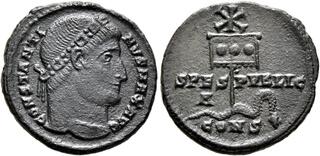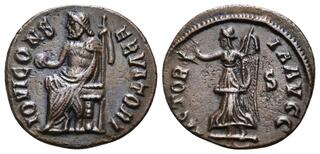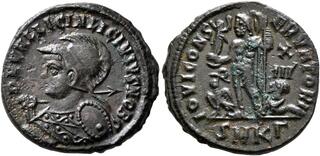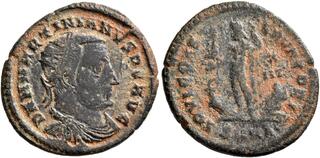Match 1:
Match 2:
Match 3:
| Leu Numismatik AG > Auction 15 | Auction date: 1 June 2024 |
| Lot number: 307 Price realized: This lot is for sale in an upcoming auction - Bid on this lot  | |
| Lot description: Constantine I, 307/310-337. Follis (Bronze, 19 mm, 2.73 g, 12 h), Constantinopolis, 327-328. CONSTANTI-NVS MAX AVG Diademed head of Constantine I to right. Rev. SPES - PVBLIC / CONS Labarum, with three medallions on drapery and surmounted by Christogram, piercing serpent; in field to left, A. RIC 26. Extremely rare and of great historical importance, and much rarer still than the laureate type (RIC 19). Somewhat rough, otherwise, about extremely fine. From the collection of Dr. L. Ramskold, Part II, Leu Web Auction 26, 12 July 2023, 5398 and ex Roma XXIII, 24 March 2022, 1082. One of the most famed coin types of Late Antiquity is no doubt Constantine's 'SPES PVBLIC' reverse, showing a labarum surmounted by a Christogram piercing a serpent. At first glance, it seems like an open-and-shut case: the first openly Christian emperor introducing the first overtly Christian type in the Roman coinage, which referred to Constantine defeating the pagan Licinius, or evil in general, symbolized by a serpent. Certainly, this is the view Constantine's biographer, Eusebius of Caesarea, would have preferred (Vita Constantini 3.3), who described how the emperor had a painting commissioned for his palace in Constantinople which showed the emperor trampling a serpent while piercing it with a spear under what was presumably a Christogram. Though this view remains popular today, the past decades have seen much doubt cast upon it. Questions have been raised about the identity of the snake, the significance of the Christogram and the labarum, and, indeed, the very nature of Constantine's conversion to Christianity. Ramskold (Constantine's SPES PVBLIC coins [2020a]) has convincingly argued that to view the 'SPES PVBLIC' coinage as an explicit Christian type is to fall into the trap of Eusebius' construction of Constantine as the ideal Christian ruler. Rather, the legends and the types are so ambiguous that they could be interpreted as Christian symbols by those who truly wished it, but they mainly referred to Constantine's status as a victorious emperor. Thus, the labarum was Constantine's personal imperial standard, carried along in the campaigns against Maxentius and Licinius, while the Christogram was his victory symbol, which only later took on a Christian connotation. Indeed, both the labarum and Christogram continued to be used as Constantinian symbols under Constantine's successors, a fact seen most clearly in the coinage of Vetranio, who employed both symbols together with the legend 'HOC SIGNO VICTOR ERIS' to express his allegiance to the Constantinian house, rather than to express his identity as a Christian emperor. Moreover, while much has been made of Christianity's traditional hostility towards serpents, these also had an ambiguous status in pagan culture. Surely, serpents such as those associated with Asclepius or the Egyptian Agathodaemon were good-natured, but we may also think of Apollo battling the giant Python, or Hera sending snakes into Hercules' crib after his birth, which he then strangled. This cataloguer would argue that this, in fact, may hold the key to interpreting the 'SPES PVBLIC' type. Through his military might, blessed by the Divine (be it Sol, or Christ, or someone else), Constantine has conquered the enemies of the empire (symbolized by the serpent) time and again, be it barbarians at the gates or power-hungry tyrants within, a message which would have been palatable to pagans and Christians alike. One mystery remains, however. Ramskold's analysis indicates that the 'SPES PVBLIC' coins were withdrawn from circulation, suggesting that the reverse image had somehow become undesirable. There is no clear reason why this should be the case, though the order must have come from the court. Arguments have been made for pagan outrage over Christian symbolism, but as stated, the imagery is not strictly Christian, and the type was produced in two emissions, indicating that withdrawal did not occur immediately. Whatever the underlying reason, it only adds to the mystery of one of Constantine's most fascinating coin types. Estimate: 1500 CHF |  |
Match 4:
Match 5:








